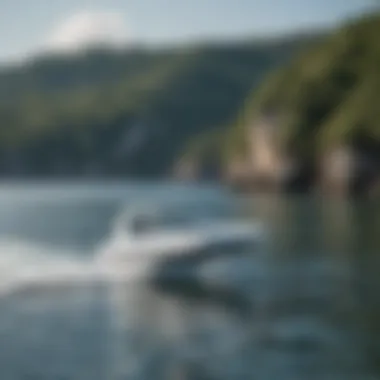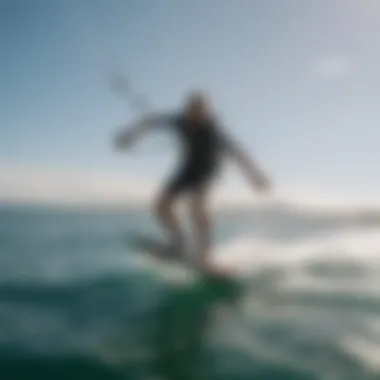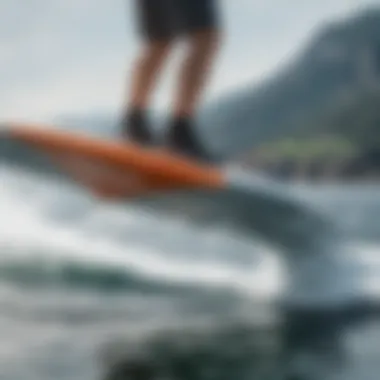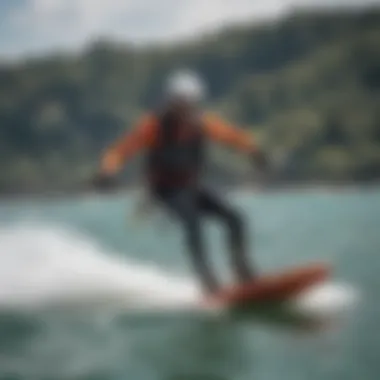Carafino Hydrofoil: Transforming the Kiteboarding Experience


Intro
The wave of innovation is hard to ignore, especially when it comes to kiteboarding. As enthusiasts chase the next exhilarating moment on the water, newer technologies, such as the Carafino Hydrofoil, have emerged as true game-changers. This novel piece of equipment is more than just a fancy add-on; it redefines how riders experience the sport.
Imagine gliding effortlessly over the surface of the water, untethered by gravity and fully in tune with the elements. This is what the Carafino Hydrofoil promises. While its sleek design catches the eye, it’s the underlying technology and engineering that set it apart from conventional kiteboards.
The hydrofoil elevates the rider, allowing for a smoother ride even in choppy conditions. Riders discover a new dimension to kiteboarding—it’s not merely about harnessing winds anymore but also about utilizing buoyancy and lift. In the following sections, we will unravel the attributes that make the Carafino Hydrofoil a must-have for both seasoned professionals and budding enthusiasts.
Prepare to dive into the intricacies of this remarkable piece of gear, exploring everything from gear selection to essential techniques. Whether you are looking to upgrade your equipment or want to learn more about integrating hydrofoiling into your riding style, this guide aims to provide you with comprehensive insights tailored specifically for you.
Honing in on gear selection and skill development, let us embark on a journey of discovery that will enrich your kiteboarding experience like never before.
Prologue to Hydrofoiling
The emergence of hydrofoiling in kiteboarding has certainly stirred up excitement in this thrilling sport. Understanding hydrofoiling isn't merely about mastering a new technique or riding gear; it's about embracing an innovative approach that redefines the way enthusiasts interact with wind and water. As kiteboarders dive into the possibilities presented by the Carafino hydrofoil, it becomes clear that this technology transcends traditional board designs.
Hydrofoils elevate the rider above the surface of the water, creating a unique experience that is distinct from conventional kiteboarding. This progression into hydrofoiling not only enhances performance but also opens the doors for new tricks and maneuvers that were once thought impossible. Moreover, it's not just about speed; it’s also about the gliding sensation, which provides a dreamy ride that feels almost surreal. Riders find themselves skimming over the water, connecting better with the environment, all while enjoying a level of efficiency that is hard to match!
What is Hydrofoiling?
Hydrofoiling refers to the technique of using a hydrofoil—a wing-like structure designed to lift the board and rider above the water surface. This lift is generated through water flow, reducing drag and allowing the rider to glide smoothly over waves and choppy water. Contrary to traditional methods, where the board stays in contact with the surface, hydrofoiling allows for a sensation akin to flying. It's a marvel to behold, as riders can traverse vast distances with less effort, capitalizing on every gust of wind with finesse.
The components of a hydrofoil typically include a mast, fuselage, and wings. The mast serves as the vertical part that connects the board to the wings submerged below. The wings are critical to generating lift, much like airplane wings create altitude.
What sets hydrofoiling apart is its ability to function in lower wind conditions, making it versatile across varying environments. Once intrigued, many find themselves captivated by the simplicity yet complexity of this riding style, sparking a deeper interest in mastering its nuances.
Brief History of Hydrofoil Technology
The roots of hydrofoil technology can be traced back to the early 1900s. It was the brainchild of innovators like Emmanuel de Rhino, who designed the first hydrofoil craft, aiming for mobile watercraft that could achieve high speeds. Fast forward to the late 20th century, it was during the 1970s that hydrofoils began to pop up in various sports, including sailing.
In kiteboarding, the climb to popularity was gradual but significant. Initially, dedicated kiteboarders experimented with makeshift hydrofoils, combining creativity and resourcefulness. This trend gained momentum as manufacturers began producing specialized hydrofoils. Notably, the advent of materials like carbon fiber advanced the design, making them lighter and more robust.
Now, companies like Carafino are leading the charge, pushing the limits of hydrofoil design to make it accessible for everyone, from novices to experienced riders. As kiteboarding continues to evolve, hydrofoiling has not just become a trend but has arguably revolutionized the sport. It's fascinating to see how far the technology has come and to ponder where it might go next.
Overview of Carafino Hydrofoil
In the rapidly evolving world of kiteboarding, the importance of understanding the Carafino hydrofoil cannot be overstated. This state-of-the-art piece of equipment is more than just a tool; it’s a game-changer that melds technology with performance. By offering distinct advantages over traditional kiteboards, the Carafino hydrofoil has etched its identity in the niche of hydrofoiling enthusiasts.
The design and functionality of Carafino hydrofoil hold significance because they address common challenges faced by many kiteboarders. It enables riders to experience an exhilarating sense of freedom, gliding seamlessly over the water’s surface with minimal drag. With unique characteristics tailored for both beginners and seasoned aficionadoes, this hydrofoil promotes an accessible transition into the world of hydrofoiling.
Design Features
The design features of Carafino hydrofoil stand out for their meticulous attention to detail and enhanced functionality. At first glance, the sleek lines and engineered shape signal innovation; however, it’s the performance that truly captures the attention.
For one, the foil’s wings are crafted to provide maximum lift at relatively low speeds. This allows riders to ascend smoothly without the need to wait for ideal wind conditions. The overall structure is often slightly lighter than its counterparts, helping in easy maneuverability and control. Moreover, the hydrofoil comes with adjustable components, enabling users to fine-tune their riding experience according to personal preference. This adaptability can be especially valuable for those still learning the ropes.
Another notable design aspect is the board’s stance options, catering for various riding styles. Riders can select a configuration that feels natural to them, allowing for a comfortable and enjoyable session on the water.
Material Selection
Material selection plays a pivotal role in the Carafino hydrofoil’s success. The choice of materials goes beyond aesthetics; it influences the performance and longevity of the equipment. Typically, Carafino opts for a blend of carbon fiber and durable plastics, balancing weight and strength perfectly.
The use of carbon fiber is significant. It’s light yet incredibly strong, which is essential when mastering the challenges of hydrofoiling. A lighter board allows the rider to optimize performance, particularly during choppy waters or strong winds. Additionally, the composites are resistant to wear and tear, making them homebodies to the rigors of saltwater environments.
"The Carafino hydrofoil’s superior material selection leads to enhanced performance while ensuring that riders can trust their gear to withstand tough conditions."
Moreover, the hydrofoil also utilizes advanced manufacturing techniques. Processes like heat molding and layering help to ensure that each component is tailored to functional perfection. This type of commitment to quality shows that Carafino doesn’t just aim to meet expectations - it aims to exceed them, creating a reliable and robust product.
Finale


Understanding the Carafino hydrofoil is crucial in appreciating its transformative role in kiteboarding. With standout design features and advanced material selections, it sets a new benchmark in the hydrofoiling realm. As enthusiasts explore this innovative technology, they will likely discover an enhanced riding experience, elevating their journeys across the waves.
Advantages of Using Carafino Hydrofoil
The Carafino hydrofoil is not just another gadget on the water; it’s a game-changer that offers a cornucopia of advantages for kiteboarders. As sports enthusiasts look for that edge—whether it's catching air more efficiently or gliding over the water with finesse—the Carafino seems to tick all the boxes. The advantages are multifaceted, addressing aspects like performance, speed, efficiency, and the undeniable joy of riding. Let’s break these elements down to explore why this hydrofoil stands out.
Performance Enhancements
When it comes to performance, the Carafino hydrofoil absolutely excels. Many riders have experienced that significant bump in their capabilities once they switch to this innovative equipment. The sensation of being elevated above the water offers riders a radically different perspective. The hydrofoil design minimizes drag, allowing for smoother transitions and tighter turns.
Coupled with its durability, the Carafino makes it easier for riders to push their limits and try new maneuvers, without the constant worry of equipment failure. The higher lift achieved by this hydrofoil means that riders can take off earlier, taking advantage of less wind. All in all, it turns challenges into opportunities right on the water.
Speed and Efficiency
Speed is often the holy grail for kiteboarders, and with the Carafino hydrofoil, this goal is more attainable than ever. Hydrofoils are known for their ability to slice through the water, and the Carafino executes this to perfection. Riders have noted an increase in top speeds, with some claiming gains of up to 30% compared to traditional boards.
Furthermore, the efficiency of energy use is another crown jewel. Less physical exertion is needed to maintain speed, allowing riders to focus on control rather than fighting the elements. This enhanced efficiency also translates to longer sessions on the water, maximizing the fun without burning out quickly.
Riding Experience
Riding with a Carafino hydrofoil is an experience in its own right. It's often hard to put into words, but many riders say it feels like flying. The sensation of gliding above the surface of the water is liberating and can transform the way one perceives kiteboarding entirely. Even when the wind conditions aren’t perfect, the hydrofoil allows for a smoother ride over choppy waters.
"With the Carafino, it’s like the obstacles vanish under me. I can just ride with ease," a rider emphasized in a forum post about their experience with the hydrofoil.
Moreover, the sense of stability it provides leads to increased confidence, especially for those just starting out or looking to hone their skills. Riders often report feeling more connected to the board, resulting in smoother transitions between tricks and a more cohesive experience.
In summary, adopting the Carafino hydrofoil unlocks a multitude of advantages, making it a worthwhile investment for serious enthusiasts. Performance peaks, enhanced speed, and an exhilarating riding experience converge to set the Carafino apart from the rest.
Understanding the Mechanics of Hydrofoils
Diving into the world of hydrofoiling unveils a fascinating interplay of physics and design that revolutionizes kiteboarding. Understanding how hydrofoils work is crucial for anyone eager to elevate their riding experience. This segment will break down the key mechanics of hydrofoils and why they matter to both enthusiasts and professionals alike.
How Hydrofoils Work
At its core, a hydrofoil is designed to lift the board above the water's surface, significantly reducing drag. When a rider accelerates, water flows over the hydrofoil's wings. These wings, shaped akin to an airplane's, create differences in pressure above and below the surface. This pressure differential is what generates lift. The fundamental concept behind this is Bernoulli's principle, which states that an increase in the speed of a fluid occurs simultaneously with a decrease in the fluid's pressure.
The effectiveness of a hydrofoil comes from its ability to glide smoothly, achieving speeds that traditional boards struggle to match. Decreasing resistance means that riders can take full advantage of wind power, allowing for more thrilling experiences on the water. The sensation of flying above the waves is both exhilarating and fundamentally different from conventional kiteboarding, where the board remains in contact with the water.
"Hydrofoiling is like discovering a new dimension of kiteboarding, where speed and agility redefine the ride."
Lift Generation
Lift is the holy grail of hydrofoiling—it’s what enables the board to soar above the water. To generate lift efficiently, several factors come into play:
- Wing Design: The shape and angle of the hydrofoil wing determine how effectively it can generate lift. Different profiles may work better in various wind conditions.
- Speed: The faster the board travels, the more lift is produced. Riders quickly learn that getting up on the foil requires a good burst of speed.
- Angle of Attack: This refers to the angle between the hydrofoil and the oncoming water flow. A slight adjustment can dramatically impact lift and efficiency. Too steep can lead to excessive drag, while too shallow may fail to generate sufficient lift.
Understanding lift also helps kiteboarders refine their technique. The key here is balance; finding that sweet spot where the rider maintains equilibrium while the foil generates lift can mean the difference between effortless flight and face-plants in the water. With practice, riders can manipulate the lift to perform tricks and maneuvers that push the boundaries of what kiteboarding can achieve.
In summary, grasping the mechanics behind hydrofoils transforms one’s approach to kiteboarding. The moments spent floating above the water are not just about speed but also about mastering the art of gliding.
Kiteboarding with Carafino Hydrofoil
Embarking on a kiteboarding journey using the Carafino hydrofoil opens up a world of possibilities for thrill-seekers and enthusiasts alike. The importance of this topic lies in understanding how this innovative technology can enhance one's kiteboarding experience, and ultimately lead to a more exhilarating ride. Kiteboarding with the Carafino hydrofoil not only offers riders unmatched performance correction in choppy conditions but also facilitates a smooth ride, even on waves.
Getting Started
Getting started with the Carafino hydrofoil is less about understanding complex mechanics and more about feeling the experience firsthand. First-timers should focus on a few vital tips to ensure that they get the most out of their hydrofoiling sessions.
- Know Your Environment: Familiarize yourself with wind conditions and water currents. Ideal learning conditions include either small waves or flat water, with winds not exceeding twenty knots for beginners.
- Take It Slow: When you first strap into the hydrofoil, start small. Begin with short sessions to maintain control while getting a feel for the lift it generates. This device has a learning curve, so patience will pay off.
- Practice Balance: Balance is key to mastering hydrofoiling. Focus on keeping your body centered over the board. A little shift can throw your whole ride off.


"Hydrofoiling requires a different sense of balance, so don’t get discouraged at first. Every ride teaches you something.”
Essential Gear and Setup
Equipping yourself with the right gear is critical for maximizing your time on the water. Here are some essentials:
- Wind-Specific Kites: While the Carafino hydrofoil is remarkably versatile, using the right kite according to wind conditions enhances performance. Make sure to select a kite that suits your skill level and the forecast.
- Hydrofoil Board: Besides the Carafino hydrofoil itself, a suitable board is necessary to complement your hydrofoil experience. For less experienced riders, consider a wider board that offers additional stability.
- Safety Gear: Wearing a helmet and impact vest is non-negotiable. These items provide much-needed protection, especially for new learners. An adjustable harness can also ensure comfort during prolonged rides.
- Footstraps: Footstraps are your link to the board, allowing you to maneuver better. Make sure they are adjustable and provide a secure hold without being overly tight.
- Maintenance Kit: Regular upkeep is key. Invest in a basic maintenance kit containing a screw driver, wrenches, and some lubricant for those moments when your equipment needs a quick fix on—the-go.
Understanding how to set up your gear properly is also paramount. Here’s a quick guide:
- Attach the Hydrofoil: Secure the hydrofoil properly to the board, making certain that it’s aligned correctly and that all screws are tightened.
- Adjust the Footstraps: Ensure footstraps are fitted to your foot size, an adjustment might be necessary as your skills progress.
- Test Your Setup: Before hitting the waters, go through a short checklist to confirm that everything is in working order. This includes checking the kite lines and ensuring there are no visible damages to any gear.
By thoughtfully approaching the setup of your Carafino hydrofoil and understanding the foundational elements of kiteboarding, you are setting yourself up for success on the water. The synergy between the right equipment and rider skill can lead to a truly euphoric hydrofoiling adventure.
Training and Skill Development
Training and skill development are essential facets of mastering the art of kiteboarding with the Carafino hydrofoil. This segment delves into why honing these skills not only enhances individual performance but also enriches the overall experience on the water. As kiteboarding becomes more popular, understanding the nuances associated with hydrofoiling is crucial for riders looking to improve their proficiency and safety.
Learning to maneuver a hydrofoil requires dedication and a clear grasp of the fundamental techniques. Comprehensive training often includes both practical lessons and theoretical understanding. Riders benefit from structured lessons which emphasize safety protocols and efficient use of the hydrofoil, allowing for a safe progression from beginner stages to more advanced maneuvering.
Basic Maneuvers
Mastering basic maneuvers can feel like learning to walk before one runs. These initial skills lay the groundwork for more complex movements down the line. Here are some key beginners’ maneuvers:
- Starting off: Learning how to launch the kite properly sets your entire session up for success. Positioning the kite in the right zone ensures that you catch the wind effectively.
- Controlling speed: Understanding how to manage your speed while on the hydrofoil is vital. This is best practiced in calm water where one can comfortably get used to the lift.
- Simple turns: Practicing basic turns helps riders gain confidence in shifting weight and adjusting the angle of the foil underfoot. This is crucial for maintaining balance and enhancing control.
- Stopping safely: Stopping safely is an often-overlooked skill. It involves learning how to come down gently without losing control, preventing mishaps that could lead to injuries.
As riders master these basic maneuvers, they develop a deeper understanding of their equipment and the way hydrofoils interact with water. This learning phase is both exciting and necessary, as it ensures a solid foundation for future tricks and movements.
Advanced Techniques
Once riders feel comfortable with the basics, they can dive into advanced techniques that really set hydrofoiling apart. These skills demand a greater level of control, balance, and precision. Here’s a glimpse of some advanced maneuvers:
- Carving turns: This technique involves engaging the foil and turning sharply. It requires a good sense of balance and the ability to read the water beneath.
- Jumps and aerial tricks: With practice, riders can learn to execute jumps that add flair to their ride. This often necessitates understanding how to use the kite’s power effectively during these maneuvers.
- Transitions: Smoothly switching from one direction to another while maintaining speed can enhance performance. Advanced riders often make these transitions look effortless, but it takes significant practice to achieve.
- Foil riding in waves: Navigating waves introduces unique challenges. Developing skills to ride on swells maximizes the hydrofoil’s advantages, allowing for an exhilarating connection with nature.
As these techniques get mastered, riders should pay attention to their body positioning and weight distribution. The relationship between the rider, the kite, and the hydrofoil demands precise control and deep awareness of the sailing environment.
"Training not only develops physical skills, but it also nurtures a rider's mental resilience and enthusiasm toward tackling new challenges."
Each stage of learning, whether basic or advanced, encourages an ongoing dialogue between the rider and the elements. Investing time in training and skill development makes all the difference in enhancing the overall kiteboarding journey with the Carafino hydrofoil.
Safety Considerations
When engaging in a thrilling sport like kiteboarding, the importance of safety cannot be overstated. With the addition of hydrofoils, which elevate riders above the water, understanding safety measures becomes paramount. The excitement of gliding above the surface is undeniable, but the necessity for calculating risk and wearing appropriate gear can be the difference between an exhilarating experience and a dangerous mishap.
Risk Management
In the world of kiteboarding, particularly with the Carafino hydrofoil, having a solid grasp on risk management is indeed crucial. Riders must be aware of changing weather conditions, as strong winds can affect the kite’s stability, leading to unfortunate accidents. It's advisable to constantly check wind patterns and forecasts. Here are some strategies for managing risks effectively:
- Pre-ride Assessment: Always assess local water conditions. Check for current strength, wind direction, and any obstacles in the area, like boats or buoys.
- Skill Level: Riders should gauge their skill set realistically. Hydrofoiling can require a higher level of mastery compared to riding traditional boards, so it’s best to practice in safe environments before venturing into challenging spots.
- Buddy System: Kiteboarding is often safer when done with friends. Having a buddy can help in emergencies, whether that's providing assistance or calling for help.
- Emergency Protocols: Understand what to do if something goes awry. For example, knowing how to detach from your gear quickly can be a lifesaver in unexpected situations. Being prepared makes a world of difference.
Recommended Safety Gear
Choosing the right gear is essential for those wanting to engage in kiteboarding with a hydrofoil. Not only does it enhance performance, but proper equipment also plays a pivotal role in safety. Consider the following gear essentials for your next adventure:
- Impact Vest: This helps protect your torso during activities, especially if you’re prone to crashes.
- Helmet: Wearing a helmet can shield your head from potential impacts while falling or colliding with equipment.
- Wetsuit: Besides warmth, a wetsuit offers an extra layer of protection against scrapes and bumpy impacts with the water.
- Leash: Always attach a leash to your kite. This prevents it from flying away if you lose control.
- Buoyancy Aid: A buoyancy aid helps keep you afloat in case of a mishap.
"By prioritizing safety gear, you not only protect yourself but also enhance your overall riding experience. Riding with confidence brings immeasurable enjoyment."
Environmental Impact of Hydrofoiling


Hydrofoiling has ushered in a new chapter in kiteboarding, captivating enthusiasts and professionals alike with its innovative design and unique performance characteristics. However, as with any sport, it’s crucial to critically assess its environmental implications. The environmental impact of hydrofoiling is not just about how the sport interacts with nature, but also about how practitioners can champion sustainability while enjoying their passion.
Sustainability in Kiteboarding
Sustainability represents a core consideration for the modern kiteboarder. As the sport grows in popularity, sustained thriving ecosystems depend on mindful practices that protect natural habitats. The adoption of hydrofoil technology reflects a significant step in this direction.
- Minimal Water Disruption: Hydrofoils elevate riders above the water, reducing drag and minimizing disturbances in marine environments. Unlike traditional boards, which can churn up sediment and affect aquatic life, hydrofoiling glides smoothly, thereby preserving fragile ecosystems below.
- Efficient Use of Energy: Hydrofoils are designed to efficiently harness wind energy, allowing riders to reach higher speeds with less power input. This not only enhances the performance but lessens the wear and tear on gear, leading to longer-lasting equipment that has less overall impact on the environment.
- Promoting Eco-Friendly Materials: Many brands, including Carafino, are beginning to incorporate sustainable materials in their hydrofoil designs. This shift towards eco-conscious manufacturing processes demonstrates a commitment to sustainability, urging the industry to align with environmental best practices.
Conservation Efforts
The responsibility of kiteboarders extends beyond individual practice; collective efforts in conservation are crucial for maintaining the integrity of oceanic and freshwater ecosystems. Various organizations and communities have rallied to promote initiatives that directly pertain to the user community of hydrofoiling.
- Cleanup Initiatives: Speed-loving kiteboarders have joined forces in organized beach clean-ups, often leveraging their presence and passion for the sport to foster community involvement. The aspect of riding for a cause has become a rallying point for many enthusiastic groups.
- Education and Awareness Campaigns: Many kiteboarding communities are actively involved in raising awareness about the ecological footprints of their sport. Hosting workshops and spreading knowledge on sustainability practices helps ensure that riders understand the impact of their activities and take actionable steps towards conservation.
- Contributing to Research Efforts: Organizations related to watersports are beginning to fund aquatic research aimed at studying the effects of marine environments on sports activities, while simultaneously working to protect local ecosystems. Participating in these efforts not only benefits the environment but solidifies the bond between the sport and its natural surroundings.
"In the end, what matters isn’t just the thrill of the ride but how we protect the spaces we love."
Future Trends in Hydrofoil Technology
The landscape of hydrofoiling is moving swiftly, much like the riders gliding over water. As kiteboarding gains more traction globally, so does the evolution of hydrofoil technology. Staying ahead of the curve means understanding what's on the horizon—whether that’s new materials, designs, or performance-enhancing features. These trends not only influence how kiteboarders engage with the sport, but also how companies like Carafino redefine the experience for enthusiasts. Here’s a closer look at two pivotal trends: emerging innovations and their potential impact on the market.
Emerging Innovations
Addressing the innovations expected to unfold in hydrofoil technology is crucial. One significant development is the refinement of composite materials that promise increased durability while remaining lightweight. For instance, materials like carbon fiber and advanced plastics are becoming more prevalent, allowing boards to be both nimble and resilient.
Additionally, we might see improvements in the design of foils themselves. Engineers are tinkering with shapes and sizes to optimize lift and drag ratios, ensuring that riders spend more time gliding above the water rather than battling against it. The introduction of variable geometry foils—those that adapt their shape during use—could also revolutionize performance capabilities. Such innovation could cater to riders’ varying skill levels and preferences, making hydrofoiling more accessible.
"Embracing innovations is not just about performance; it’s about evolving the whole kitboarding experience for diverse riders."
Key Innovations to Watch
- Smart Foiling Systems: integration of sensors that adjust the foil dynamics in real-time based on speed and rider weight.
- Eco-Friendly Materials: rise in more sustainable material options to minimize environmental impact.
- User-Friendly Designs: boards designed for a wider range of skill levels, promoting inclusivity within the sport.
Potential Market Impact
The domino effect of these innovations on the market is substantial. As hydrofoil technology continues to advance, it's likely to create a ripple effect across various sectors. With enhanced performance, we could see an influx of riders wanting to experience the thrill for themselves. This potential boost in demand could lead to increased competition among manufacturers, resulting in even more innovations.
Moreover, as the industry attracts more newcomers, brands like Carafino have the chance to fine-tune their offerings to cater to recreational kiteboarders and professional athletes alike. This widening of the market can foster a culture of progression, promoting training resources and workshops to equip riders with the skills they need.
Market Influencers
- Increased Participation: more innovations mean more riders trying out hydrofoiling; enticing a broader audience.
- Advanced Training Programs: as the number of enthusiasts grows, so too the demand for quality instructors and materials.
- Collaborations with Environmental Groups: companies can team up to promote sustainable practices, making the sport more appealing to eco-conscious riders.
In summation, the future of hydrofoil technology, particularly concerning Carafino's offerings, brims with promise. Innovators and companies alike need to remain agile to adapt to the changing tides of the market. By keenly observing trends, stakeholders can ensure that this exciting new frontier of kiteboarding continues to elevate the experience for all.
The End
The conclusion of this article serves to reinforce the significant role that the Carafino hydrofoil plays in the kiteboarding community. As we’ve explored throughout the discussion, this hydrofoil stands not merely as a piece of gear but as a pivotal transformation in how riders experience the sport. By emphasizing key aspects such as its design innovations, performance enhancements, and environmental consciousness, we can appreciate how the Carafino hydrofoil shifts the paradigm for kiteboarders at all skill levels.
Recap of Key Points
To summarize:
- Innovation in Design: The Carafino hydrofoil features cutting-edge design elements that enhance stability and performance.
- Performance Enhancements: Riders benefit from improved speed, control, and overall efficiency, making for a more exhilarating ride.
- Safety and Considerations: Safety gear and risk management strategies specific to hydrofoiling ensure that enthusiasts can ride with confidence.
- Environmental Awareness: The hydrofoil's design reflects a commitment to sustainability, with innovations that contribute to reducing the environmental footprint of kiteboarding.
These elements highlight not just the performance improvements but also underline the type of community that embraces responsible riding practices.
Final Thoughts on Carafino Hydrofoil
The Carafino hydrofoil is more than just an advancement in technology; it's a move toward elevating the entire kiteboarding experience. As kiteboarding continues to gain traction around the world, the integration of hydrofoil technology represents an exciting frontier. Riders looking to enhance their skills and experiences will find that the Carafino hydrofoil not only supports their ambitions but also connects them to a broader ethos of innovation and environmental stewardship.
In a field that's ever-evolving, the Carafino hydrofoil exemplifies what it means to revolutionize sport, offering not just a ride but a way to engage with the elements in an exciting, responsible manner. As enthusiasts continue to explore the potential of hydrofoiling, they symbolize a dynamic community leaning towards a future filled with possibilities.
"Riding on a hydrofoil goes beyond mere performance; it’s about the melding of individual skill and the spirit of the environment."
Completing this journey toward hydrofoiling, kiteboarders can look forward to not only mastering the art but also pioneering a more sustainable path in kiteboarding.















